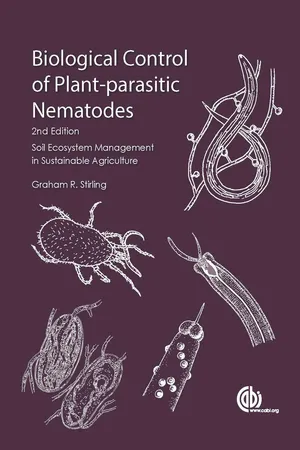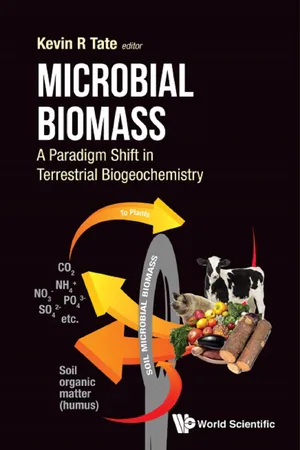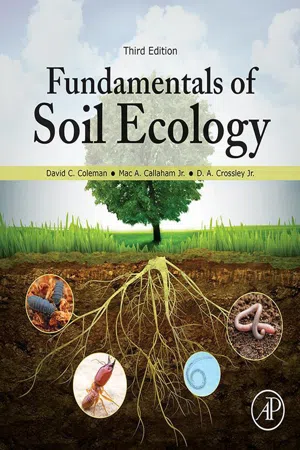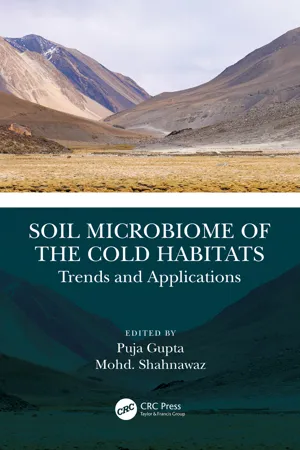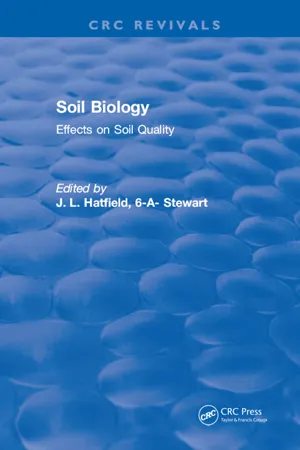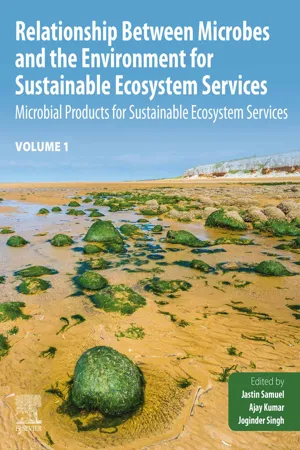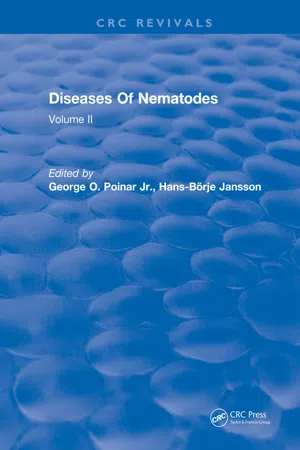Biological Sciences
Nematodes in Soil
Nematodes in soil are microscopic roundworms that play important roles in nutrient cycling, decomposition, and soil health. They can be both beneficial and harmful to plants, as some nematodes are parasitic and can damage crops, while others contribute to soil fertility by breaking down organic matter and releasing nutrients. Understanding the diversity and ecological functions of nematodes in soil is crucial for sustainable agriculture and ecosystem management.
Written by Perlego with AI-assistance
Related key terms
8 Key excerpts on "Nematodes in Soil"
- eBook - ePub
- Walter Traunspurger, Walter Traunspurger(Authors)
- 2021(Publication Date)
- CAB International(Publisher)
7 Role of Nematodes in the Food Web: Nematodes as Predator and PreyCHRISTOPH PTATSCHECKAnimal Ecology, Bielefeld University, Bielefeld, Germany7.1 Introduction7.2 Nematodes, a Nutritious Meal?7.3 Investigating the Trophic Interactions of Nematodes7.3.1 Gut content analysis and observations of feeding behavior7.3.2 Functional response assessments7.3.3 Functional response assessments using nematodes7.3.4 Impact of the sediment on predation7.3.5 Experimental settings using microcosms and enclosures/exclosures7.4 Nematodes as Predators7.5 Nematodes as Prey7.5.1 Nematodes as prey for protozoans7.5.2 Nematodes as prey for invertebrates (meio- and macrofauna)7.5.3 Impact of invertebrate predation on natural nematode communities7.5.4 Nematodes as prey for vertebrates7.5.5 Impact of predation by juvenile fish on natural nematode communities7.5.6 Long-term effects of predation on nematode population dynamics7.6 Conclusions and Perspectives7.1 IntroductionHighlights• Nematodes are both predators and prey for organisms ranging from protozoans to vertebrates, based on gut analyses and direct observations.• Nematodes have numerous trophic links in benthic food webs, but the implications for benthic communities are still unclear.• Functional response experiments, microcosm studies, and enclosures/exclosures in the field can be used to investigate the intensity of these trophic interactions and their impact on individual species as well as entire communities.Nematodes are an abundant and species-rich taxon in benthic environments and their diversity is reflected in their feeding types. Depending on the species-specific morphology of their mouth cavity (see Chapter 6 ), the diet of nematodes mainly consists of bacteria, algae (microphytobenthos), plants and roots, and fungi, but omnivorous and predatory species that feed on protozoans or other meiofaunal organisms are also known (Majdi and Traunspurger, 2015 ). The occurrence of predatory nematodes is often related to the trophic state of the water body inhabited by these species, with higher abundances occurring in more nutritious environments (Michiels and Traunspurger, 2005 ;Schroeder et al., 2012; Ptatscheck and Traunspurger, 2014 ). Thus, while the relative proportion of predatory species within a nematode community is usually about 10%, it may exceed 51% (e.g. Barbuto and Zullini, 2005 ). Nonetheless, little is known about the feeding ecology of predatory nematodes in freshwater environments (Majdi and Traunspurger, 2015 - eBook - ePub
Biological Control of Plant-parasitic Nematodes
Soil Ecosystem Management in Sustainable Agriculture
- Graham Stirling(Author)
- 2014(Publication Date)
- CAB International(Publisher)
Over the last three decades, there has been a major increase in research in soil microbial ecology, and the scientific literature is replete with books, reviews and papers on soil biodiversity, decomposition processes, the soil food web, rhizosphere effects, microorganism–invertebrate interactions and many other related topics. We now know much more about the soil biological community than we did 30 years ago, but this knowledge has not been translated into improvements in the way soil organisms are managed on-farm. For example, research has shown that nematode pests can be suppressed by naturally occurring parasites and predators, and ecologists often indicate that biological suppressiveness is an important ecosystem service, but most farmers have no knowledge of these issues. They assume that crop losses from nematodes are inevitable, and are usually not aware that nematodes have natural enemies that could possibly provide an alternative to nematicides and resistant cultivars.In my opinion, the above situation is the result of the detachment that exists between agricultural scientists, soil ecologists and the farming community. The lack of interaction between the former groups is particularly concerning, and is manifested in some of the issues outlined as follows.• Many agricultural scientists do not view agriculture from an ecological perspective. They focus on maximizing the provisioning services provided by cropping and livestock enterprises, and give little thought to the many other services that an agroecosystem should provide. Their understanding of the energy flows and nutrient cycling processes that occur within agroecosystems is generally relatively simplistic, and their knowledge of soil biological processes is limited. This lack of detailed ecological knowledge, particularly as it relates to soil biology, means that agricultural scientists are unlikely to read the ecological literature, and rarely talk to soil ecologists. Much the same criticism could be applied to discipline-based specialists who work with soil. They tend to work with a limited range of organisms, and their ecological knowledge is often limited to understanding how abiotic factors such as temperature or moisture influence particular soilborne pests or pathogens. - eBook - ePub
Microbial Biomass: A Paradigm Shift In Terrestrial Biogeochemistry
A Paradigm Shift in Terrestrial Biogeochemistry
- Kevin R Tate(Author)
- 2017(Publication Date)
- WSPC (EUROPE)(Publisher)
In a similar way that the advent of new methods for measuring soil microbial biomass opened the way for a spate of studies on the role of soil microorganisms in nutrient and carbon cycling (Jenkinson and Powlson, 1976), a new generation of tools for interrogating the diversity and functional role of complex below-ground communities has helped to spawn a new era of soil biodiversity research. This new research has not only extended the concept of soil microbial biomass to consider the rich diversity of microbial form and function in soil, but also it has revealed the existence of highly complex networks of biotic interactions in soil that play a major role in shaping plant communities and the functioning of terrestrial ecosystems (Bardgett and van der Putten, 2014). This is what this chapter is about: summarising how understanding of the functional role of soil biodiversity has advanced over recent decades, in terms of ecosystem processes, vegetation dynamics and ecosystem resilience to global change and identifying future challenges for soil biodiversity research.A Short History of Soil Biodiversity ResearchThe importance of soil organisms for soil fertility has long been known. Aristotle referred to earthworms as ‘the intestines of the earth’, and Cleopatra, the last pharaoh of Egypt, declared them to be sacred because of their contribution to Egyptian agriculture. In his last book, published in 1881, Darwin detailed the importance of earthworms for soil fertility and biogeochemical cycles, and in the late 1800s and early 1900s, pioneering work of the Russian microbiologist Winogradsky established some of the fundamental roles that soil microbes play in the nitrogen and sulphur cycles. Despite all this historic wisdom, it was not until the 1980s when ecologists began to seriously explore the functional role of ecological interactions in soil. Initial work in this area focused on the role of trophic interactions in soil food webs for processes of decomposition and nutrient cycling (Anderson et al., 1983; Coleman et al., 1983; Clarholm, 1985), and plant nutrient acquisition and growth (Ingham et al., 1985; Setälä and Huhta, 1991), and of root-associated organisms, especially mycorrhizal fungi and root-feeding fauna, as drivers of nutrient cycling (Read, 1991) and vegetation dynamics (Grime et al., 1987; Brown and Gange, 1989). Around the same time, information on soil food webs was starting to be incorporated into ecosystem models of carbon and nutrient cycling (Hunt et al., 1987), and models were also developed to examine functional consequences of shifts in food web energy channels in soil (Moore and Hunt, 1988). These, and other studies, laid the foundation for subsequent work that showed below-ground multi-trophic interactions to serve as important drivers of ecosystem processes of decomposition and nutrient cycling and that the rate and magnitude of ecosystem processes depends on the architecture of soil food webs (Bardgett, 2002; Mikola et al - eBook - ePub
- David C. Coleman, Mac A. Callaham, D. A. Crossley Jr.(Authors)
- 2017(Publication Date)
- Academic Press(Publisher)
For more information on dynamics of entomopathogenic Nematodes in Soil food webs, see Strong (2002). For identifying fungal-based food chains, Ruess et al. (2002) have shown that the measurement of fatty acids specific to fungi can be traced to the body tissues of fungal-feeding nematodes. Although still in early stages of development, this technique shows considerable promise for more detailed biochemical delineation of food sources of specific feeding groups of nematodes. Because of the wide range of feeding types and the fact that they seem to reflect ages of the systems in which they occur (i.e., annual vs perennial crops, old fields, pastures, and more mature forests), nematodes have been used as indicators of overall ecological condition (Bongers, 1990 ; Ferris et al., 2001 ; Ferris and Bongers, 2006 ; Vervoort et al., 2012). This is a growing area of research in land management and soil ecology, one in which the intersection between nematode and other soil faunal community analysis and ecosystem function could prove to be useful for assessing land damage and restoration (Wilson and Kakouli-Duarte, 2009 ; Domene et al., 2011). 4.3.2.2 Nematode Zones of Activity in Soil As noted in Chapter 2, Two Primary Production Processes in Soils: Roots and Rhizosphere Associates, the rhizosphere is a zone of considerable metabolic activity for root-associated microbes. This extends also to the soil fauna, which may be concentrated in the rhizosphere. For example, Ingham et al. (1985) found up to 70% of the bacterial- and fungal-feeding nematodes in the 4%–5% of the total soil that was rhizosphere, namely the amount of soil 1–2 mm from the root surface (the rhizoplane). In comparison, Griffiths and Caul (1993) found that nematodes migrated to packets of decomposing grass residues, with considerable amounts of labile substrates therein, in pot experiments - eBook - ePub
Soil Microbiome of the Cold Habitats
Trends and Applications
- Puja Gupta, Mohd. Shahnawaz, Puja Gupta, Mohd. Shahnawaz(Authors)
- 2023(Publication Date)
- CRC Press(Publisher)
82.2.4.1 Protozoa
Sarcomastigophora and Ciliophora are soil and litter protozoa. Flagellates, naked amoebae, Testacea and ciliates are ecological groups. Flagellates have whip-like flagella and are the most numerous and active protozoa. They depend on bacteria for nutrient cycling. Desert soils had 102–105 g−1 values.9 Amoebae, insatiable soil protozoa, inhabit agricultural, grassland and wooded soils. Amoebae and larger species like ciliates eat phagotrophically. Testate amoebae are rarer than naked ones except in wet, forested areas. Ciliates have unusual life cycles and complex generating patterns. They outnumber other categories. Ciliates feed on microorganisms in soil pores and fissures. Refractory ciliates appear in food-rich environments.2.2.4.2 Rotifera
Water film soil usually includes these tiny animals. Rotifera are 0.05–3 mm long and not listed in soil biota compendia. Dry Antarctic Valley soils contain rotifers. Rotifers are distinguished by their pseudo-segmented body wall (lorica), “crown” with cilia, and feeding mechanism with strong muscles and jaws. Nine out of ten soil rotifers are Bdelloidea. Besides “biogeochemical cycles,” their importance is uncertain.102.2.5 Mesofauna
Mesofauna occupy air-filled pores, primarily existing ones. Soil mesofauna taxa, commonly known as microarthropods, include terrestrial Aptera. Acari, Collembolans, Proturans, Diplurans, Symphellids and Enchytraeids are also included. Microarthropods link microfauna and microorganisms to mesofauna, since they feed on nematodes and fungi.112.2.5.1 Nematoda
Soil nematodes are multicellular roundworms. Four out of every five organisms are nematodes. As below-ground parasites and plant pathogens, nematodes regulate decomposition and NPP. Nematodes are “tubes within tubes” that devour a variety of meals. They consume bacteria, fungi, plant feeders, omnivores and predators.12 - eBook - ePub
Soil Biology
Effects on Soil Quality
- J. L. Hatfield(Author)
- 2018(Publication Date)
- CRC Press(Publisher)
Earthworms and other Fauna in the Soil Edwin C. Berry
I. IntroductionI. Introduction II. Earthworms A. Classification and Ecological Significance B. Distribution and Abundance C. Population Determinants D. Burrows E. Burrow Function F. Casts III. Decomposition and Nutrient Release IV. Enchytraeidae V. Other Soil Arthropods A. Collembola — Mites VI. Insects A. Hymenoptera VII. Research Needs References Soil organisms range in size from protozoa which may be less than 5 μm in length and weigh < 10-10 gm to earthworms, which may attain lengths of > 1 meter and diameters of >20 mm and weights in excess of 500 gms (Lee and Foster, 1991). These organisms are found within the soil matrix occupying existing pore spaces as well as within the litter layer. Soil arthropods have been arranged and separated into groups based upon their associations with the soil. Eisenbeis and Wichard (1985) distinguished three groups which consisted of euedaphon, epedaphon, and hemiedaphon. Euedaphic forms primarily inhabit the lower soil layers in existing pore systems. Their diameter is restricted to the size of the pores in this region. Organisms in these regions are usually round or have worm-like body forms. Epedaphic forms live on the soil surface and in the litter layer. Epedaphic organisms are not restricted in size to conform to pore diameters, and body forms are highly variable. Hemiedaphic forms do not occupy positions between the euedaphic and epedaphic forms. Usually the hemiedaphic form is a temporary form of life enabling the organisms to occupy existing, or more often, self-made burrows in the soil during unfavorable environmental conditions, for example, to avoid desiccation and cold.Swift et al. (1979) recognized that body width, from a functional standpoint, was more important in defining the extent in which soil animals are constrained by, or modify, the structure of soil and litter habitats. Accordingly, soil invertebrates were divided into three classes: micro- (< 100 /xm), meso- (< 1–2 mm) and macro-fauna (< 10–20 mm). The microfauna (primarily Protozoa and Nematoda) are primarily associated with waterfilms and water filled voids and do not modify the structure of soils nor contribute to the formation of particulate organic matter (Anderson, 1988). Mesofauna consist of enchytraeids, Collembola (insects), and Acarina (mites), and are primarily associated with air filled pores. This group feeds primarily on organic matter and fungal hyphae associated with decomposing organic matter. Fecal matter from this group contribute aggregates to the surface horizons. The macrofauna include isopods, millipedes, earthworms, ants, and termites and are considered to be more important than the micro- and meso-fauna in affecting soil structure through their feeding and burrowing habits. - eBook - ePub
Relationship Between Microbes and the Environment for Sustainable Ecosystem Services, Volume 1
Microbial Products for Sustainable Ecosystem Services
- Jastin Samuel, Ajay Kumar, Joginder Singh Panwar(Authors)
- 2022(Publication Date)
- Elsevier(Publisher)
Fig. 1 Representation of sustainable ecosystem between earthworms and microflora.The earthworm body secretes mucus and nitrogenous excretion in their habitat which is useful for soil ecology because the microbiota functions have been strengthened in soil which followed biodegradation of organic matters and may be function as microbial primers. Earthworm develops castings a by-product of gut passage which are primarily in globular and granular forms; these are features of different sizes, high stability and periods also in microbial activities variation. Globular casts are large in size and more stable as compared with granular casts. Due to more stability, globular casts are more important and useful for mineralization.2.1.2: Role of rhizosphere
The rhizosphere (a zone around root system) is directly and indirectly affected by the earthworms that follow the growth and development of the plant. The earthworm feed and behavior in rhizosphere are the direct effects of the earthworm while indirectly influencing the soil texture, physiological, physiochemical, and biological mechanisms that affect the growth of the root and plant. Different visual findings, i.e., root volume, duration, and quantity can be easily accessed by earthworm activities in the rhizosphere; mycorrhizal and soil bacterial activities, etc. (Beven and Germann, 1982 ; Zaller et al., 2011 ; Liu et al., 2014 ). Recently organic farming has great importance than the conventional system because of soil organic matters in organic system. Soil bulk density and porosity are correlated to each other; porosity influence by the addition of organic matters which directly affects the bulk density, i.e., reduction in density; this effect is in organic farming systems and is important for root growth and nutrient availability. The higher soil respiration is always directly proportional to higher microbial activity in the organic farming system because of continuous addition of organic matters; which is most suitable for microbes and follows the high biological activity and rapid decomposition. Because of soil organic matters in the organic system, organic farming has been of great significance lately than the conventional system. Soil bulk density and porosity are related to each other; porosity influence through the addition of organic matter that directly affects bulk density, i.e., density reduction; this effect is important for root growth and nutrient availability in organic farming systems. Higher soil respiration is often directly related to higher microbial activity in the organic farming system because of the continuous inclusion of organic matter that is most appropriate for microbes and follows elevated biological activity and rapid decomposition. Thus we can say the porosity is directly related with soil organic matters and indirectly with the soil bulk density (Cui et al., 2013 ; Liu et al., 2014 ; Yan et al., 2018 ; Esmaeilzadeh and Ahangar, 2014 - eBook - ePub
Diseases Of Nematodes
Volume II
- George O Poinar(Author)
- 2019(Publication Date)
- CRC Press(Publisher)
As we approach the end of the twentieth century there has never been a greater need to find alternative methods of nematode control. In some countries, the fumigants dibromochloropropane and ethylene dibromide, which have formed the basis of nematode control programs on many crops since the end of World War II, have been removed from the market because of health and environmental considerations. The use of others such as methyl bromide and 1,3 dichloropropene is being reviewed, while the long-term future of the nonvolatile nematicides, seen as alternatives to the fumigants in many crops, is clouded following the recent discovery of some of them in groundwater. With the increasing cost of testing and registering pesticides, the development of new nematicides has almost ground to a halt, so that additional nonchemical means of nematode control will have to be found. Biological control will play an increasing role in practical nematode control in the future and this chapter aims to evaluate the present position, some of the problems limiting its development, and some of the prospects for the future.II. Population Regulation
All plant-parasitic nematodes spend at least some part of their lives in soil, one of the most complex of habitats. Within that environment nematode populations do not increase indefinitely because they are constrained by a number of physical and biological factors. There are many excellent discussions on the dynamics of animal populations and the mechanisms which regulate them6 , 7 , 8 , 9 , 10and this topic will not be discussed in detail here. Suffice to say that two major forces regulate natural populations: those that are not influenced by the density of the organism and those that are density dependent.The mortality factors that operate independent of density are largely meteorological and physical. In the soil environment they include extremes of moisture and temperature, and normal agricultural practices such as plowing and plant destruction. They also include various polyphagous parasites and predators. Although these antagonists do not depend on a specific organism for food, they may take a relatively constant toll of that organism incidental to their survival on other substrates. In studies with insects, physical hazards, and nonspecific antagonists have been shown to have drastic effects on the number of insects in a population and may be the major factors limiting abundance when insect populations are at their lowest level. However, they do not regulate those populations.10
Learn about this page
Index pages curate the most relevant extracts from our library of academic textbooks. They’ve been created using an in-house natural language model (NLM), each adding context and meaning to key research topics.

